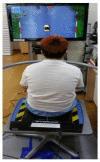The Effect of Virtual Reality Exercise Program on Sitting Balance Ability of Spinal Cord Injury Patients
- PMID: 33572242
- PMCID: PMC7915104
- DOI: 10.3390/healthcare9020183
The Effect of Virtual Reality Exercise Program on Sitting Balance Ability of Spinal Cord Injury Patients
Abstract
(1) Background: Virtual reality (VR) is a useful device for rehabilitation therapy. The purpose of this study was to examine the effect of virtual reality exercise program on sitting balance with spinal cord injury; (2) Methods: 20 subjects who selected on the basis of the screening criteria were divided into the experimental group (n = 10) who underwent the virtual reality exercise program and rehabilitation therapy and the control group (n = 10) who underwent a regular sitting balance training program and a regular rehabilitation therapy. Each intervention consisted of a 30-min session a day, three times a week, for eight weeks. In order to measure functions of the sitting balance, FSA (force sensitive application) and LOS (limit of stability) were used before and after the treatment intervention; (3) Results: We found significant differences for the FSA, LOS between pre-test and post-test in the 2 groups; (4) Conclusions: The findings of this study suggest that virtual reality exercise program can be applied as a useful approach for spinal cord injury patients.
Keywords: sitting balance ability; spinal cord injury; virtual reality system.
Conflict of interest statement
The authors declare no conflict of interest.
Similar articles
-
Combined Effect of Virtual Reality Training (VRT) and Conventional Therapy on Sitting Balance in Patients with Spinal Cord Injury (SCI): Randomized Control Trial.Neurol India. 2022 Sep-Oct;70(Supplement):S245-S250. doi: 10.4103/0028-3886.360934. Neurol India. 2022. PMID: 36412376 Clinical Trial.
-
Does the addition of virtual reality training to a standard program of inpatient rehabilitation improve sitting balance ability and function after stroke? Protocol for a single-blind randomized controlled trial.BMC Neurol. 2016 Mar 31;16:42. doi: 10.1186/s12883-016-0563-x. BMC Neurol. 2016. PMID: 27036515 Free PMC article. Clinical Trial.
-
The effects of semi-immersive virtual reality therapy on standing balance and upright mobility function in individuals with chronic incomplete spinal cord injury: A preliminary study.J Spinal Cord Med. 2018 Mar;41(2):223-229. doi: 10.1080/10790268.2017.1369217. Epub 2017 Sep 7. J Spinal Cord Med. 2018. PMID: 28880130 Free PMC article.
-
Effects of Virtual Reality Therapy on Gait and Balance Among Individuals With Spinal Cord Injury: A Systematic Review and Meta-analysis.Neurorehabil Neural Repair. 2020 May;34(5):375-388. doi: 10.1177/1545968320913515. Epub 2020 Apr 9. Neurorehabil Neural Repair. 2020. PMID: 32270736
-
Effectiveness of virtual reality on balance ability in individuals with incomplete spinal cord injury: A systematic review.J Clin Neurosci. 2020 Feb;72:322-327. doi: 10.1016/j.jocn.2020.01.037. Epub 2020 Jan 16. J Clin Neurosci. 2020. PMID: 31956089
Cited by
-
VirtualCPR: Virtual Reality Mobile Application for Training in Cardiopulmonary Resuscitation Techniques.Sensors (Basel). 2021 Apr 3;21(7):2504. doi: 10.3390/s21072504. Sensors (Basel). 2021. PMID: 33916716 Free PMC article.
-
Effects of virtual reality rehabilitation after spinal cord injury: a systematic review and meta-analysis.J Neuroeng Rehabil. 2024 Oct 28;21(1):191. doi: 10.1186/s12984-024-01492-w. J Neuroeng Rehabil. 2024. PMID: 39468617 Free PMC article.
-
A Virtual Reality Algorithm for the Study of Clinical Efficacy of Sports Injury Rehabilitation Training.J Healthc Eng. 2021 Sep 30;2021:6725625. doi: 10.1155/2021/6725625. eCollection 2021. J Healthc Eng. 2021. Retraction in: J Healthc Eng. 2023 Jun 28;2023:9876212. doi: 10.1155/2023/9876212. PMID: 34630993 Free PMC article. Retracted.
-
Effectiveness of immersive virtual reality training to improve sitting balance control among individuals with acute and sub-acute paraplegia: A randomized clinical trial.J Spinal Cord Med. 2023 Nov;46(6):964-974. doi: 10.1080/10790268.2021.2012053. Epub 2021 Dec 22. J Spinal Cord Med. 2023. PMID: 34935603 Free PMC article. Clinical Trial.
-
Rehabilitation to Improve Outcomes after Cervical Spine Surgery: Narrative Review.J Clin Med. 2024 Sep 10;13(18):5363. doi: 10.3390/jcm13185363. J Clin Med. 2024. PMID: 39336849 Free PMC article. Review.
References
Grants and funding
LinkOut - more resources
Full Text Sources
Other Literature Sources


